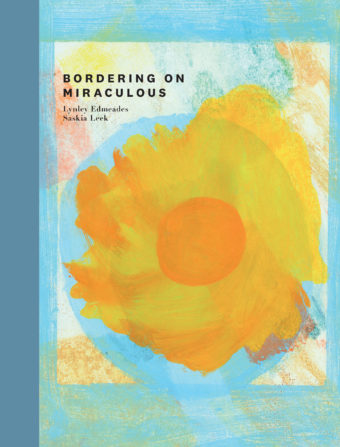At first read/look, the poems by Lynley Edmeades and paintings by Saskia Leek in Bordering On Miraculous have much in common. Both have a tonal delicacy or restraint — Saskia in terms of her (for the most part) muted pastel palette and the light touch of her thin brush strokes, Lynley in the economy of her (for the most part) understated content and the elegant deftness of her lines and rhythms. They seem compatible, a good match. Obvious differences in tone and presence might have heightened the drama and contrast of this meeting and its ensuing conversation. As it is, the fascination of the exchange between two women (who an interview reveals were already familiar with each other’s work) owes less to their obvious compatibility and more to the subtle directions of shifting impulses within their exchanges — how the moments in their conversation originate and how responses follow, or, sometimes, seem not to.
The sense of location and identity — of origination — in Saskia’s paintings feels secure, in that they appear to stand alone. There’s an internal consistency, often in terms of iterations and motifs. The negotiations within them and their associated or neighbouring images seem internal to an existing world. In this world there are some repeated representational forms (mugs, bananas, flowers, clock-faces, and others); forms whose exact borders between representation and abstraction are somewhat fluid (suns or fried eggs? Fruits? Window frames? Clouds? Are colour grids abstractions or things?); and coloured fields or shaped areas of colour that are or appear to be abstract, but may be the sea, the sky; or simply the colour field/ground on which objects are placed, in which case the definition ‘abstract’ is a misnomer. These rich interplays both page by page and across successive or neighbouring pages are conversational, or even, at times, narrativistic, suggesting relations, conversations and even stories that have what feels — reads — like a largely self-contained environment.
By contrast, Lynley’s poems often seem responsive in a variety of ways, in that they may depend on their relationships to the paintings for their situations and what they have to say or have been invited to say. For example, on page 27 there is an image of what is surely a yellow sun on a brown scumbled ground with rays reaching out across an area of glow. The poem notices
the slow melt of general
warmth and how the sun
often comes to be the centre.
The reaching suggests a casual
spreading with a few
nostalgic licks of brown.
But then:
The circle is the centre
is the place of insistence.
It calmly asks: what if
yellow is the thing?
And then, an apparent non-sequitur, but, in fact, a deliberate dérive or refocus to one of the poet’s key preoccupations:
What if it’s ok to sleep
with the baby in the bed?
So, any absolute distinction between the apparently self-contained world of images and the descriptively responsive one of the poems doesn’t really play, and in fact breaks down at certain key points (the baby as ‘centre’ of ‘general warmth’?), as in the second pairing in the book, in which the poem introduces us to the new baby who will feature in several more poems, such as the one quoted above. In the early poem, in which a new mother expresses both parental absorption and pleasure (‘Look at all the little things’) and frustration (‘he wakes: we curse’), we encounter the line, ‘every day: look baby: can you see the birds:’, and on the facing page find an image of folded-back green curtains, the top and bottom sections of window frame, and framed by these an expanse of what must be blue sky with a single black ‘m’-shaped cipher for bird wings. Is the bird connection between painting and poem coincidental? Surely not; but which came first? And does it matter, except as one of the teasing pleasures of the exchange?
On page 76 are loosely brushed vertical stripes of various colours. The facing poem notices ‘a stripe of miraculous straining/ a stripe of perpendicular straining/ a straining bigger than the stripe’; followed by more variations, ending with ‘a stripe of ordinary miraculous straining’. While this catalogue or list with its accumulation of adjectives is a kind of description of what we see, the adjective ‘miraculous’ and the noun-adverb ‘straining’ are owning or framing the description in ways not apparent in the image itself, except to the extent that ‘straining’ can describe the appearance of a substance strained through a perforated filter such as a sieve or indeed the sieving bristles of a brush. So, what is being sieved and what makes the process miraculous — allowing also for the suggestion of effort implied by ‘straining’; and what kinds of strain-effort are required by miracles? Clearly, the painted stripes are the origin of this exchange; but the result of them getting parsed by the words ‘miraculous’ and ‘straining’ (effort and process) has involved a responsive engagement, a dialogue, even a kind of supplemental ownership.
Which raises the question: where are the borders in these exchanges, the places of crossings or relocations or sharing? Perhaps they simply exist wherever we encounter a shared sense of vivid surprise — astonishment — across a border of dialogue where the effort or straining required is the ‘ordinary’ but in its way miraculous one of engagement, of sustaining the empathy of conversation.
Both participants hint at something like this in their interview responses to the pleasantly leading question, ‘Did this partnership between you present challenges or was it perhaps energising?’ Saskia notes that, ‘I’ve realised that I’m not an illustrator, but I do like working alongside words.’ Linley’s response acknowledges the impacts of ‘visual prompts’: ‘… I really enjoy working with visual prompts and with visual artists. I find it really frees me from being too in my head about an idea; having the visual somehow pulls me into the material world, even when that world is somehow concept-driven, like much of Saskia’s work.’ A little later, she adds, ‘… we quickly decided we didn’t want the pieces to be descriptive of the images; rather, we were more interested in how our practice and conceptual thinking overlapped. I found this much more exciting and freeing, while it took a little bit of getting used to.’
‘A little bit of getting used to’ isn’t a bad way to describe the moment-by-moment pleasure of encountering these vivid exchanges.
This review was originally published on the Academy of NZ Literature site.



